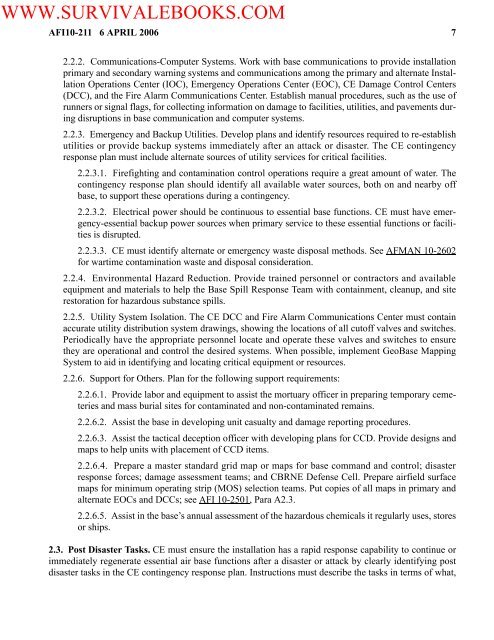2006 US Air Force CIVIL ENGINEER ... - Survival Books
2006 US Air Force CIVIL ENGINEER ... - Survival Books
2006 US Air Force CIVIL ENGINEER ... - Survival Books
- No tags were found...
Create successful ePaper yourself
Turn your PDF publications into a flip-book with our unique Google optimized e-Paper software.
WWW.SURVIVALEBOOKS.COMAFI10-211 6 APRIL <strong>2006</strong> 72.2.2. Communications-Computer Systems. Work with base communications to provide installationprimary and secondary warning systems and communications among the primary and alternate InstallationOperations Center (IOC), Emergency Operations Center (EOC), CE Damage Control Centers(DCC), and the Fire Alarm Communications Center. Establish manual procedures, such as the use ofrunners or signal flags, for collecting information on damage to facilities, utilities, and pavements duringdisruptions in base communication and computer systems.2.2.3. Emergency and Backup Utilities. Develop plans and identify resources required to re-establishutilities or provide backup systems immediately after an attack or disaster. The CE contingencyresponse plan must include alternate sources of utility services for critical facilities.2.2.3.1. Firefighting and contamination control operations require a great amount of water. Thecontingency response plan should identify all available water sources, both on and nearby offbase, to support these operations during a contingency.2.2.3.2. Electrical power should be continuous to essential base functions. CE must have emergency-essentialbackup power sources when primary service to these essential functions or facilitiesis disrupted.2.2.3.3. CE must identify alternate or emergency waste disposal methods. See AFMAN 10-2602for wartime contamination waste and disposal consideration.2.2.4. Environmental Hazard Reduction. Provide trained personnel or contractors and availableequipment and materials to help the Base Spill Response Team with containment, cleanup, and siterestoration for hazardous substance spills.2.2.5. Utility System Isolation. The CE DCC and Fire Alarm Communications Center must containaccurate utility distribution system drawings, showing the locations of all cutoff valves and switches.Periodically have the appropriate personnel locate and operate these valves and switches to ensurethey are operational and control the desired systems. When possible, implement GeoBase MappingSystem to aid in identifying and locating critical equipment or resources.2.2.6. Support for Others. Plan for the following support requirements:2.2.6.1. Provide labor and equipment to assist the mortuary officer in preparing temporary cemeteriesand mass burial sites for contaminated and non-contaminated remains.2.2.6.2. Assist the base in developing unit casualty and damage reporting procedures.2.2.6.3. Assist the tactical deception officer with developing plans for CCD. Provide designs andmaps to help units with placement of CCD items.2.2.6.4. Prepare a master standard grid map or maps for base command and control; disasterresponse forces; damage assessment teams; and CBRNE Defense Cell. Prepare airfield surfacemaps for minimum operating strip (MOS) selection teams. Put copies of all maps in primary andalternate EOCs and DCCs; see AFI 10-2501, Para A2.3.2.2.6.5. Assist in the base’s annual assessment of the hazardous chemicals it regularly uses, storesor ships.2.3. Post Disaster Tasks. CE must ensure the installation has a rapid response capability to continue orimmediately regenerate essential air base functions after a disaster or attack by clearly identifying postdisaster tasks in the CE contingency response plan. Instructions must describe the tasks in terms of what,
















